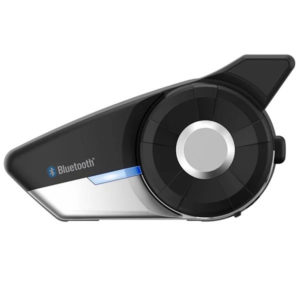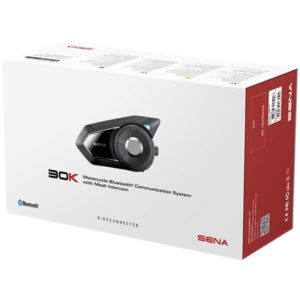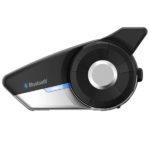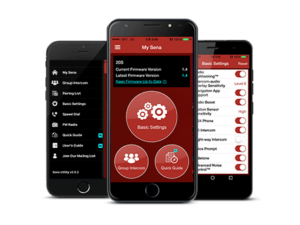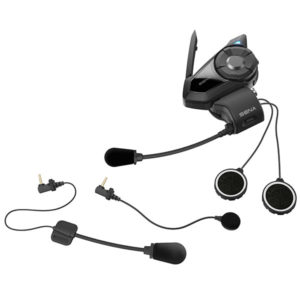With more and more headsets on the market and the ever-changing nature of the tech which supports them – getting the right one for you can be tricky.
Let’s look at Sena’s 20s and 30k models.
Because their hardware is almost identical and the price difference is negligible, many people are confused.
We thought we’d lay it out as simply as possible.
Sena 30K
Next Generation Tech
Premium level intercom from industry leader – Sena, now incorporating cutting edge ‘mesh’ connectivity.
If you want to future proof your gear, buying this headset makes sense.SportsBikeShopAmazon
Sena 20S Evo
Tried and Tested
Feature packed intercom, for those who want to keep things simple.
If you won’t require the “Mesh” connectivity it may make sense to get this easier to control model. SportsBikeShopAmazon
Save Money On Your Motorcycle Insurance
- You could pay less than £195*
- Compare quotes from 25+ UK providers
- Fill in one form to compare top bike insurers
Bottom Line Upfront
This is easy to explain without the need of a list.
- The only difference between these headsets is that the 30k includes a proprietary “mesh” processor
This tech allows self-healing networks and an open, mesh network of 1.2 miles with a potentially unlimited number of connections (to other mesh devices).
If you’ve a minimum of 5 other riders with this tech installed, you can extend a mesh network over 5 miles in ideal conditions.
This is a huge improvement over bluetooth’s 1.2 mile limit.
The speakers, microphones and cables are all identical in both units.
It’s also important to note that the 30k includes the same bluetooth processor as the 20s.
This allows it to connect to older Sena devices and generic bluetooth devices over a 1.2 mile radius (same as the 20s).
- The 30k offers the same bluetooth functions as a 20s model
So for your extra cash, you’re getting a mesh processor with improved functionality over bluetooth.
You’ll only see these benefits if the other riders in your group have mesh headsets.
What’s In The Box
Both headsets ship with the unit and integrated clamp, two speakers, a wired mic and wired boom mic, some adhesive stickers and rubber shims.
The additional mesh processor in the 30k is built into the unit so doesn’t require any extra components.
Read: Sena 30K Full Review
Read: Sena 20s Full Review
Winner: No differences so a tie
Installation And Mounting
Sena’s whole range use a similar system.
The main unit mounts on the bottom left of your helmet shell, the speaker cables are run behind the cheek pads, speakers are placed in the cutouts and the mic is attached.
They’ve made all of this painless with both models, and we like that you can take everything off without leaving any permanent marks.
Both the 20s and 30k ship with foam spacers and a range of foam speaker covers to help you dial in a good fit.
Winner: No differences so a tie
Size And Weight
The 30k weighs 61 grams, the 20s 60 grams – nothing in it.
The 20s is slimmer, probably explained by the 30k housing an extra processor.
There’s not much in it though and neither feels like it’s contributing to wind noise or buffeting.
The placement of Sena units on the bottom left of the helmet means they’re discreet-looking as well as silent for most riders.
Winner: Very little between the two units – another tie
Helmet Compatibility
Probably to appeal to as many markets as possible, Sena make their headsets compatible with open-face, full-face and flip up helmets.
Most UK riders wear full-face or modular, and so use the wired mic on the inside.
We’ve seen these set up neatly on open-face helmets in hotter countries though.
So long as it was made in the last 10 years and isn’t a ‘pudding bowl’, your helmet should be fine.
Winner: No differences – another tie
Controls And App
Here’s where my opinion on the two starts to differ,
Both units are controlled with a jog dial and button system, and it works well.
Sena make their buttons large and controls ‘clicky’ to give feedback even with gloved hands,
I spent time with the 20s first, and that may be why I found it harder to remember all the combinations of button presses for the 30k.
Either way – the 30k has a lot of combos to remember if you want to control things on the fly.
The 20s has fewer features, but it’s easier to memorise the layout.
The app is slightly different for each unit, with mostly the same core features.
Most of them are laid out in a simple on/off list, and even the advanced ones are easy to get to grips with.
Again, the 30k is a little more involved on account of having more features.
Winner: 20s – easier to remember controller mapping
Bluetooth/Mesh Pairing
Bluetooth/mesh pairing options for other headsets, phones or GPS devices are controlled by holding button combinations for a set number of seconds.
The problem with the 30k is that there are too many combos to remember.
This would get easier with time and is an inevitable consequence of there being so many features.
The 30k has to map phone, GPS, mesh and bluetooth connection buttons.
But the 20s still feels more intuitive to us.
The 20s’ shake to pair feature is one we like – shaking the unit pairs it to the last recognised device.
This is handy for getting back on the bike after short stops.
Connection to other mesh devices with the 30k is simple (automatic in open mode).
The simplicity of this is why we think mesh is the future.
The important thing to take away is that the bluetooth functionality is the same for both headsets.
You’ll only see the benefits of the mesh technology if other riders in your group are using the same.
Winner: 30k – Once mesh technology is widely adopted the 30k will make everything so simple
Sound Quality
Like we said at the start, apart from an extra processor, the hardware is the same in both units.
Same speakers.
Same microphones.
The audio through these sets is crystal clear with good voice reproduction and decent audio quality for music.
Customisable inserts and pads mean you can mount speakers snugly.
Sena’s noise reduction technology is present in both models, meaning comms, audio and navigation can be heard clearly without having to crank up the volume to cover road/wind noise.
Winner: No differences – tie
Range
The bluetooth processors in both units support a 1.2 mile range in ideal conditions.
Changes in elevation can drastically shorten this.
The 30k’s mesh processor can, with a minimum of 6 riders connected, extend its range to 5 miles in ideal conditions.
Remember, this is only if connected to other mesh devices.
Winner: 30k – The mesh networking effect extends range significantly
Battery Time/Charging
The 30k’s mesh feature draws more power than bluetooth, so two times are required.
In mesh mode expect 8 hours of talk time and about 13 hours in bluetooth mode.
The 20s gets you about 13 hours of talk time.
The 30k charges in 1.5 hours and includes a quick charge function – a 20 minute charge at a fuel stop gets you an additional 3 hours.
The 20s charges in 2.5 hours and doesn’t feature a quick charge function.
Winner: 30k – charges more quickly and has a quick charge feature
Waterproofing
Sena’s headsets are listed as ‘water resistant’.
And while we’ve never had any trouble with them in wet UK weather, there are some on the internet who’ve had problems.
As far as we can tell, anything short of total immersion should be OK.
Winner: No differences – another tie
Price
The 30K is slightly more expensive but to be honest there is very little difference, you will be spending a good chunk of change on either of these options. (One thing to note, if you are buying for two riders the dual packs are better value.)
Winner: 20k is slightly cheaper
Buy Online
Sena 30K
- Single pack
- Dual pack (better value)
Sena 20s
- Single pack
- Dual pack (better value)
Conclusion
There’s no doubt that a 5 mile wide, self-healing network sounds amazing, and many riders are ready to put the hassle of bluetooth behind them.
The question is whether or not this technology will become widely adopted.
So far “mesh” is proprietary Sena tech. Either way the 30K offers all the same functions as the 20S with next generation tech on top.
At this level the price difference is small and we think it makes more sense to future proof and go for 30K.
Hopefully, its competitors will release some compatible gear soon and the proliferation of this superior comms tech can begin.


